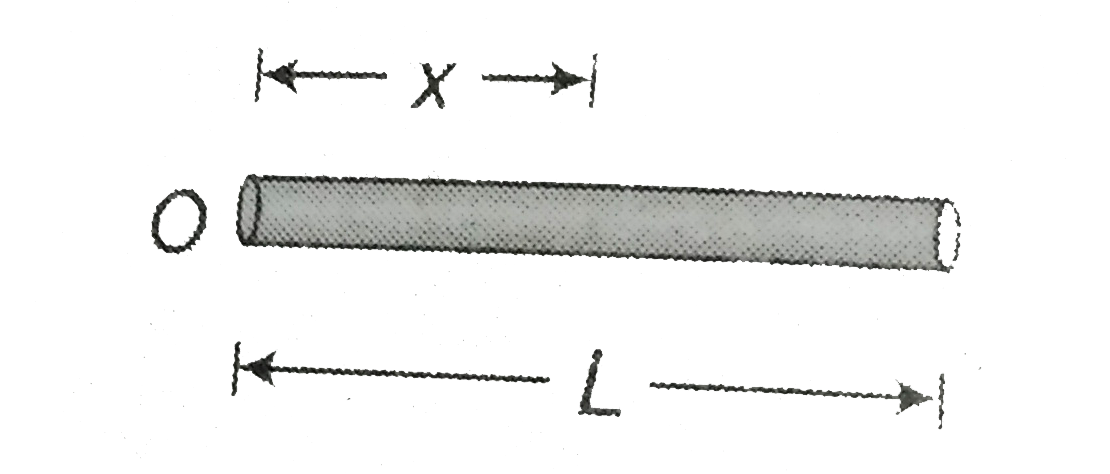A rod of length L and cross section area A has variable density according to the relation ρ(x)=ρ0+kx for 0≤x≤L2 and ρ(x)=2x2 for L2≤x≤L where ρ0 and k are constants. Find the mass of the rod.Solution in Gujrati
The correct Answer is:(7L312+ρ0L2+kL28)A
M1=L/2∫0A(ρ0+kx)dx=(ρ0L2+kL28)A
M2=L∫L/2A(2x2dx)=23[L3−L38]=14L324A
Mtotal=M1+M2=(14L324+ρ0L2+kL28)A
Topper's Solved these Questions
- MISCELLANEOUSBOOK - ALLEN CHAPTER - MISCELLANEOUSEXERCISE - EXERCISE-5(A)
15 Videos
- MISCELLANEOUSBOOK - ALLEN CHAPTER - MISCELLANEOUSEXERCISE - Exersice -05(B)
20 Videos
- MISCELLANEOUSBOOK - ALLEN CHAPTER - MISCELLANEOUSEXERCISE - Exercise-04 [A]
28 Videos
- KINEMATICS (MOTION ALONG A STRAIGHT LINE AND MOTION IN A PLANE)BOOK - ALLEN CHAPTER - KINEMATICS (MOTION ALONG A STRAIGHT LINE AND MOTION IN A PLANE)EXERCISE - BEGINNER S BOX-7
8 Videos
- PHYSICAL WORLD, UNITS AND DIMENSIONS & ERRORS IN MEASUREMENT BOOK - ALLEN CHAPTER - PHYSICAL WORLD, UNITS AND DIMENSIONS & ERRORS IN MEASUREMENT EXERCISE - EXERCISE-IV
7 Videos
Similar Questions
Identify the pair whose dimensions are equal
View SolutionPlanck's constant has dimensions …………….
View SolutionThe x and y components of vector →A are 4m and 6m respectively. The x and y components of vector →A+→B are 10m and 9m respectively. For the vector →B calculate the following.
(a) x and y components
(b) length and
(c) the angle it makes with x-axis
View SolutionA football player kicks a ball at an angle of 30∘ with an initial speed of 20 m/s. Assuming that the ball travels in a vertical plane, calculate (a) the time at which the ball reaches the highest point (b) the maximum height reached (c) the horizontal range of the ball (d) the time for which the ball is in the air, (g=10m/s2)
View SolutionAssertion : Gravitational forces do not depend on the medium between the masses.
Reason : Mediating particle responsible for gravitational force is graviton.
View SolutionThe density of a non-uniform rod of length 1m is given by rho (x) = a (1 + bx^(2)) where a and b are constants and 0 le x le 1 . The centre of mass of the rod will be at
View SolutionThe KE and moment of inertia about the given end point of a rod of mass m and length l and cross sectional area A which is rotating with omega=sqrt(g/l) as shown in figure. Will be [density of the rod varies as rho=rho_(0)(1+x/l),x is the distance measured from O )n ]
View SolutionThe linear mass density i.e. mass per unit length of a rod of length L is given by ρ=ρ0(1+xL), where ρ0 is constant , x distance from the left end. Find the total mass of rod and locate c.m. from the left end.

View SolutionThe density of a non-uniform rod of length 1m is given by rho (x)=a (1+bx^(2)) where, a and b are constant and 0 le x le 1 . The centre of mass of the rod will be at
View SolutionAn insulting thin rod of length l has a linear charge density rho(x)=rho_(0)(x)/(l) on it. The rod is rotated about an axis passing through the origin (x=0) and perpendicular to the rod. If the rod makes n rotations per second, then the time averaged magnetic moment of the rod is :
View SolutionIf f(x)={√1+kx−√1−kxxfor−1≤x02x2+3x−2for0≤x≤1 is continuous at x = 0 then find k.
View SolutionIf f(x) = {:{((sqrt(1+ + kx ) - sqrt(1-kx))/x , " for" -1 le x lt 0) , ( 2x^(2) + 3x -2, " for " 0 le x le 1):}
continuous at x = 0 , then k is equal to
View Solution1 मीटर लम्बाई की एक असमान छड़ का घनत्व ρ(x)=a(1+bx2) द्वारा दिया गया है जहाँ a एवं b नियतांक हैं तथा 0≤x≤1. छड़ का द्रव्यमान केन्द्र _____ पर होगा।
View SolutionThe density of a non-uniform rod of length 1m is given by ρ(x)=a(1+bx2)
where a and b are constants and 0≤x≤1.
The centre of mass of the rod will be at
View SolutionA rod of length L is placed along the X-axis between x=0andx=L. The linear density (mass/length) ρ of the rod varies with the distance x from the origin as ρ=a+bx. a.) Find the SI units of a and b b.) Find the mass of the rod in terms of a,b, and L.
View SolutionAn insulting thin rod of length l has a linear charge density ρ(x)=ρ0xl on it. The rod is rotated about an axis passing through the origin (x=0) and perpendicular to the rod. If the rod makes n rotations per second, then the time averaged magnetic moment of the rod is :
View Solution
